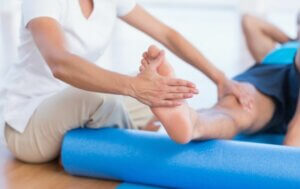Causes and Treatments of Footballer's Ankle

Since they’re so complex, there are lots of common ankle injuries. One injury that mainly affects athletes is footballer’s ankle, also known as anterior ankle impingement. Here, we’ll talk about its causes, effects, and treatment options.
What is footballer’s ankle?
First, let’s see what this injury consists of. In fact, footballer’s ankle is an injury that progressively becomes worse. Patients with this issue suffer inflammation in the joint of the tibia and talus. This is painful and reduces mobility on the front part of the joint.
As time passes, the injury leads to the appearance of osteophytes in the affected bones. Osteophytes are small pieces of bone, and in this case, they protrude from the tibia and talus.
Since it’s bone that shouldn’t be there, it becomes harder to move. Then, it can end up making it difficult to practice sports.
Causes of footballer’s ankle
There are two main positions that cause footballer’s ankle, but they irritate different parts of the joint. On one hand, extreme plantar flexion (standing on tiptoe) will pull on the anterior articular capsule of the ankle. On the other hand, extreme dorsiflexion (flexing your toes up towards your leg) will cause shocks between the anterior edge of the tibia and neck of the talus.

In fact, these are common for soccer players when they kick a ball. In addition, dancers do this when they plié or jump.
Treatment options
The first thing is to make sure you’re suffering from footballer’s ankle by ruling out other conditions. To do this, you’ll have an x-ray or MRI. That way, your doctor can see if there are bone fragments or not. Also, they’ll need to check the size of the osteophytes, which is crucial to picking the right treatment option.
If not, following the normal guidelines to reduce inflammation will be enough. Gradually, you’ll get better. To do this, you need to keep your limb raised, apply pressure and heat to the area. Also, you can take anti-inflammatory medication if necessary.
However, if there are bone fragments, you have two options, depending on how quickly you need to recover and the severity of the injury. Also, it depends on the effort of your daily routine demands.
If you have scheduled matches or performances and need to recover as quickly as possible, you could use drugs such as corticosteroids or hyaluronic acid. You could use these if it’s a mild injury, or as a temporary solution if it’s more severe.
If you have more time to recover, or if the osteophytes aren’t very large, you can use physical therapy.

There are different types of therapies that treat inflammation. Some of them relax your muscles, and others help strengthen the joint. In addition, you can accompany them with corticosteroids or hyaluronic acid.
Surgery
However, if the osteophytes are very large and there’s no other alternative, surgery is an option. In it, a surgeon will need to remove the osteophytes through arthroscopy. In fact, it’s the only way to heal if your injury is very severe.
After the operation, you’ll need to start moving your ankle as soon as possible to prevent losing mobility, then you can start walking with crutches. In approximately 45 days, you’ll be able to start running again. Then, after two months, you should be able to resume your activity as normal.
Since they’re so complex, there are lots of common ankle injuries. One injury that mainly affects athletes is footballer’s ankle, also known as anterior ankle impingement. Here, we’ll talk about its causes, effects, and treatment options.
What is footballer’s ankle?
First, let’s see what this injury consists of. In fact, footballer’s ankle is an injury that progressively becomes worse. Patients with this issue suffer inflammation in the joint of the tibia and talus. This is painful and reduces mobility on the front part of the joint.
As time passes, the injury leads to the appearance of osteophytes in the affected bones. Osteophytes are small pieces of bone, and in this case, they protrude from the tibia and talus.
Since it’s bone that shouldn’t be there, it becomes harder to move. Then, it can end up making it difficult to practice sports.
Causes of footballer’s ankle
There are two main positions that cause footballer’s ankle, but they irritate different parts of the joint. On one hand, extreme plantar flexion (standing on tiptoe) will pull on the anterior articular capsule of the ankle. On the other hand, extreme dorsiflexion (flexing your toes up towards your leg) will cause shocks between the anterior edge of the tibia and neck of the talus.

In fact, these are common for soccer players when they kick a ball. In addition, dancers do this when they plié or jump.
Treatment options
The first thing is to make sure you’re suffering from footballer’s ankle by ruling out other conditions. To do this, you’ll have an x-ray or MRI. That way, your doctor can see if there are bone fragments or not. Also, they’ll need to check the size of the osteophytes, which is crucial to picking the right treatment option.
If not, following the normal guidelines to reduce inflammation will be enough. Gradually, you’ll get better. To do this, you need to keep your limb raised, apply pressure and heat to the area. Also, you can take anti-inflammatory medication if necessary.
However, if there are bone fragments, you have two options, depending on how quickly you need to recover and the severity of the injury. Also, it depends on the effort of your daily routine demands.
If you have scheduled matches or performances and need to recover as quickly as possible, you could use drugs such as corticosteroids or hyaluronic acid. You could use these if it’s a mild injury, or as a temporary solution if it’s more severe.
If you have more time to recover, or if the osteophytes aren’t very large, you can use physical therapy.

There are different types of therapies that treat inflammation. Some of them relax your muscles, and others help strengthen the joint. In addition, you can accompany them with corticosteroids or hyaluronic acid.
Surgery
However, if the osteophytes are very large and there’s no other alternative, surgery is an option. In it, a surgeon will need to remove the osteophytes through arthroscopy. In fact, it’s the only way to heal if your injury is very severe.
After the operation, you’ll need to start moving your ankle as soon as possible to prevent losing mobility, then you can start walking with crutches. In approximately 45 days, you’ll be able to start running again. Then, after two months, you should be able to resume your activity as normal.
All cited sources were thoroughly reviewed by our team to ensure their quality, reliability, currency, and validity. The bibliography of this article was considered reliable and of academic or scientific accuracy.
- Inzulza C Alonso, Robertson C Winston. Pinzamiento anterolateral del tobillo: Evaluación ecotomográfica Rev. chil. radiol. [Internet]. 2002 [citado 2020 Ene 07] ; 8( 1 ): 28-32.
- Busto VJM, Bautista CR, Figueroa CMF, Liberato GI. Tratamiento artroscópico del pinzamiento anterolateral de tobillo en deportistas. Acta Ortop Mex 2008; 22 (2).
- Tol, Johannes L. et al. Anterior Ankle Impingement. Foot and Ankle Clinics, Volume 11, Issue 2, 297 – 310
This text is provided for informational purposes only and does not replace consultation with a professional. If in doubt, consult your specialist.








